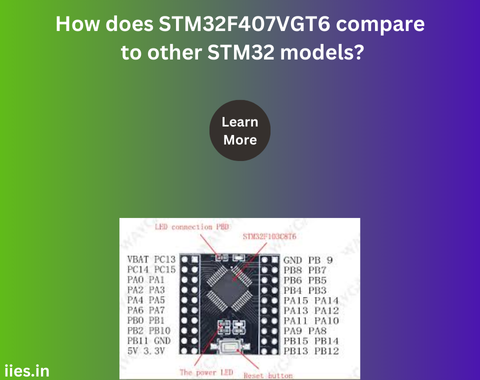
The STM32 family of microcontrollers by STMicroelectronics is renowned for its versatility, covering a broad spectrum of embedded applications. Among these, the STM32F407VGT6 stands out as a powerhouse within the STM32F4 series, offering a blend of high performance, extensive peripherals, and robust memory capabilities. As embedded systems become increasingly complex, choosing the right microcontroller from the STM32 lineup is crucial for achieving the desired balance between performance, power efficiency, and cost. This article delves into the theoretical aspects of the STM32F407VGT6, comparing it to other models in the STM32 family, to highlight its strengths and potential applications. By understanding these comparisons, developers can make informed decisions when selecting a microcontroller for their specific needs.
The STM32F407VGT6 belongs to the STM32F4 series, which is based on the ARM Cortex-M4 core. This core is known for its high-performance processing capabilities, including a digital signal processing (DSP) instruction set and a floating-point unit (FPU). Compared to other STM32 series, such as the STM32F1 and STM32F3, which use the ARM Cortex-M3 core, the STM32F407VGT6 offers superior computational power and efficiency, making it ideal for applications that require complex mathematical computations, such as signal processing and motor control.
Performance-wise, the STM32F407VGT6 operates at a clock speed of up to 168 MHz, which is higher than many other STM32 models like the STM32F103 series, which typically operates at 72 MHz. The increased clock speed of the STM32F407VGT6 allows for faster execution of instructions, making it suitable for real-time applications that demand quick response times. Additionally, the STM32F407VGT6 features a large memory capacity, with up to 1 MB of Flash memory and 192 KB of SRAM, providing ample space for complex code and data storage.
One of the standout features of the STM32F407VGT6 is its extensive peripheral set. It includes advanced peripherals like USB OTG (On-The-Go) with full-speed and high-speed support, Ethernet MAC, and multiple timers and ADCs (Analog-to-Digital Converters). In comparison, other models like the STM32F0 series are more limited in their peripheral offerings, focusing on basic functionalities for cost-sensitive applications. The rich peripheral set of the STM32F407VGT6 enables developers to implement sophisticated systems with less reliance on external components, reducing overall system complexity and cost.
When comparing power efficiency, the STM32L series, known for its ultra-low-power capabilities, typically outperforms the STM32F407VGT6. The STM32L series uses the ARM Cortex-M0+ or Cortex-M4 cores, designed with power-saving features that make them ideal for battery-powered and energy-constrained applications. While the STM32F407VGT6 is not as power-efficient, it strikes a balance between performance and power consumption, making it a versatile choice for applications that require both high processing power and reasonable energy usage.
The STM32F407VGT6 is tailored for applications requiring high performance, such as industrial automation, consumer electronics, and medical devices. Its advanced computational capabilities and rich set of peripherals make it a preferred choice for complex embedded systems. In contrast, other STM32 models, like the STM32G0 and STM32F0 series, are aimed at cost-sensitive, low-power applications, such as simple IoT devices and basic control systems.
Like other STM32 models, the STM32F407VGT6 benefits from the extensive STM32 development ecosystem, including ST’s software libraries, development boards, and the STM32CubeMX configuration tool. However, the STM32F407VGT6’s compatibility with advanced software frameworks, such as FreeRTOS and ARM’s CMSIS-DSP library, gives it an edge in developing high-performance applications.
In summary, the STM32F407VGT6 distinguishes itself from other STM32 models through its high processing power, extensive peripheral integration, and suitability for performance-intensive applications. While it may not be the best choice for ultra-low-power designs or cost-sensitive projects, its balanced combination of speed, memory, and peripheral options makes it a versatile microcontroller for a wide range of advanced embedded systems.
Indian Institute of Embedded Systems – IIES